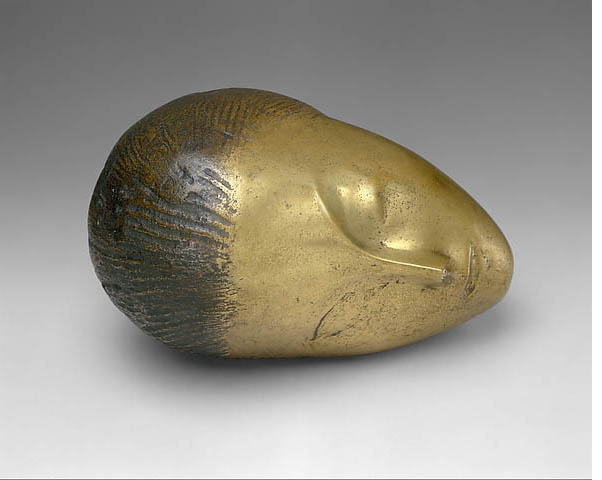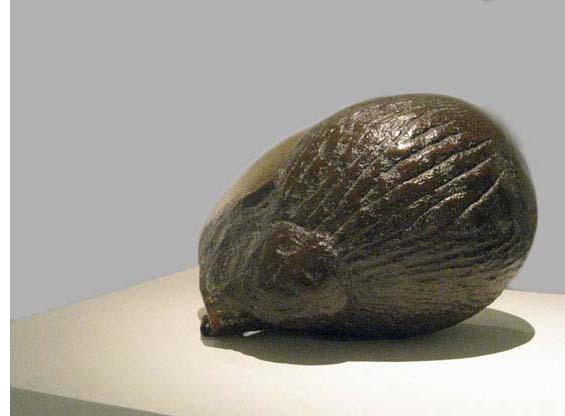I love Brancusi's "Sleeping Muse" because it puts together opposites that we are trying to put together in ourselves. Every person wants to go out to the world, and every person wants to go away from it. Every person wants to respect the world and also wants to have contempt for it. Eli Siegel described contempt as "the disposition in every person to be for themselves by making less of the outside world."
There are two directions of self in a muse who sleeps, and there are things represented in the sculpture that have been used to have contempt. Brancusi shows the "Sleeping Muse" in an astonishing way. Her head is reclining and is shown cut off from her body. It is so easy to think we can look down on a sleeping person. But Brancusi's purpose is for respect, and in her abstraction she is so alive.
 In Is Beauty the Making One of Opposites? Eli Siegel writes about Universe and Object:
In Is Beauty the Making One of Opposites? Eli Siegel writes about Universe and Object:
Does every work of art have a certain precision about something, a certain concentrated exactness, a quality of particular existence? – and does every work of art, nevertheless, present in some fashion the meaning of the whole universe, something suggestive of wide existence, something that has an unbounded significance beyond the particular?
The "Sleeping Muse" is in the elemental egg form that life comes from, a form of wide meaning, having "unbounded significance beyond the particular." The theme of this sculpture occupied Brancusi for more than 20 years. Show More...
There are two directions of self in a muse who sleeps, and there are things represented in the sculpture that have been used to have contempt. Brancusi shows the "Sleeping Muse" in an astonishing way. Her head is reclining and is shown cut off from her body. It is so easy to think we can look down on a sleeping person. But Brancusi's purpose is for respect, and in her abstraction she is so alive.
 In Is Beauty the Making One of Opposites? Eli Siegel writes about Universe and Object:
In Is Beauty the Making One of Opposites? Eli Siegel writes about Universe and Object:Does every work of art have a certain precision about something, a certain concentrated exactness, a quality of particular existence? – and does every work of art, nevertheless, present in some fashion the meaning of the whole universe, something suggestive of wide existence, something that has an unbounded significance beyond the particular?
The "Sleeping Muse" is in the elemental egg form that life comes from, a form of wide meaning, having "unbounded significance beyond the particular." The theme of this sculpture occupied Brancusi for more than 20 years. Show More...
This is one of four versions in bronze from 1910, a casting of a marble original, and over the course of his lifetime Brancusi returned to this oval form, giving his works such titles as the Genesis Series, the Newborn, and Birth of the World.
In the "Sleeping Muse", a movingly alive portrait of an actual woman, the Baroness Frachon, is given timelessly abstract form. Her features are stylized, flattened, close to not being, as the self is seemingly in sleep. In Self and World Eli Siegel writes: "One great instance of widening and contraction in terms of the self has to do with waking and sleeping. In waking we go toward what we see as the outside world, in sleeping apparently we go away from what we see as the outside world."
"Sleeping Muse" affirms what Eli Siegel shows next, that we have a relation to the world all the time even as we sleep. Look at how her features are in motion because their axis is on the diagonal, and how affecting her expression is. From the delicate narrow nose the eyebrows arch out widely and somewhat critically. Her mouth, drawn up at one side, is a little questioning, and the relation of severity and fullness is beautiful, as it is in her chin, sharply defined from the front, but generously curved from every other angle (things observed in the actual presence of the sculpture). Under the closed lids her eyes are subtly modeled. The contrasting shapes of her eyes add to the lovely asymmetry of her face and the sense of individuality, particularity, surprise.
The eyes of the "Sleeping Muse" may be shut, but her ear is open to the sounds of the world. Her thoughts continue and are represented in the adventures of her wonderful locks of hair. They are tight as they radiate from her forehead, textured and full at the back of her head, and then they come to something in the oval form at the nape of the neck. Look at the planes within the oval form – they are beautiful – and how the plane of the right temple fits the wide horizontal. Then, most moving of all, there is the golden luster of her sleeping face that goes forth into space. Eli Siegel showed that every person, even in sleep, most deeply wants to be in a just relation to the outside world.
the sounds of the world. Her thoughts continue and are represented in the adventures of her wonderful locks of hair. They are tight as they radiate from her forehead, textured and full at the back of her head, and then they come to something in the oval form at the nape of the neck. Look at the planes within the oval form – they are beautiful – and how the plane of the right temple fits the wide horizontal. Then, most moving of all, there is the golden luster of her sleeping face that goes forth into space. Eli Siegel showed that every person, even in sleep, most deeply wants to be in a just relation to the outside world.
I am grateful that through Aesthetic Realism, my desire to go away from the world was criticized and my desire to like the world was seen and encouraged. This continues in programs and classes. The guilt I felt because of the way I saw other people changed and my restless dreams ended. I have a life that is truly happy. Aesthetic Realism, including the beautiful, important "Visual Arts and the Opposites" class, is the most life-giving, practical education there is.
...Show Less
"Sleeping Muse" affirms what Eli Siegel shows next, that we have a relation to the world all the time even as we sleep. Look at how her features are in motion because their axis is on the diagonal, and how affecting her expression is. From the delicate narrow nose the eyebrows arch out widely and somewhat critically. Her mouth, drawn up at one side, is a little questioning, and the relation of severity and fullness is beautiful, as it is in her chin, sharply defined from the front, but generously curved from every other angle (things observed in the actual presence of the sculpture). Under the closed lids her eyes are subtly modeled. The contrasting shapes of her eyes add to the lovely asymmetry of her face and the sense of individuality, particularity, surprise.
The eyes of the "Sleeping Muse" may be shut, but her ear is open to
 the sounds of the world. Her thoughts continue and are represented in the adventures of her wonderful locks of hair. They are tight as they radiate from her forehead, textured and full at the back of her head, and then they come to something in the oval form at the nape of the neck. Look at the planes within the oval form – they are beautiful – and how the plane of the right temple fits the wide horizontal. Then, most moving of all, there is the golden luster of her sleeping face that goes forth into space. Eli Siegel showed that every person, even in sleep, most deeply wants to be in a just relation to the outside world.
the sounds of the world. Her thoughts continue and are represented in the adventures of her wonderful locks of hair. They are tight as they radiate from her forehead, textured and full at the back of her head, and then they come to something in the oval form at the nape of the neck. Look at the planes within the oval form – they are beautiful – and how the plane of the right temple fits the wide horizontal. Then, most moving of all, there is the golden luster of her sleeping face that goes forth into space. Eli Siegel showed that every person, even in sleep, most deeply wants to be in a just relation to the outside world.I am grateful that through Aesthetic Realism, my desire to go away from the world was criticized and my desire to like the world was seen and encouraged. This continues in programs and classes. The guilt I felt because of the way I saw other people changed and my restless dreams ended. I have a life that is truly happy. Aesthetic Realism, including the beautiful, important "Visual Arts and the Opposites" class, is the most life-giving, practical education there is.